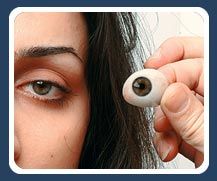|
We Made Custom-Made &Ready-Made
Prosthese from Plastic Acrylic.
Also we Produce Suction & Sceleral Shell ,
Ready-Made Prothese.
We MadeCustom-Made Artificial Eye and fitting for
all Patients.
Some of Fitting Sample
is :

The
Fitting Process
 There
are several methods of fitting an artificial eye.
Many years ago stock eyes, or (ready-made eyes),
were fit by trying different shapes into the socket
until a satisfactory lid opening was achieved. There
are several methods of fitting an artificial eye.
Many years ago stock eyes, or (ready-made eyes),
were fit by trying different shapes into the socket
until a satisfactory lid opening was achieved.
This method required the fitter to have a large
selection of stock eyes on hand to simulate the
patient's iris color and fill the shape requirements
with the iris in the right position. Fitting stock
eyes was not, and is not, considered the most
exacting method of fitting because of the guesswork
involved.
In the United States stock eyes are rarely fit any
more because of the problems they can cause, and
Board Certified Ocularists, (B.C.O.), do not use
stock eyes because of the inherent inaccuracies
sighted.
The custom-made prosthesis, as the name implies, is
made from a direct model of the socket. During the
first fitting appointment, about eight weeks
following surgery, an impression is usually taken,
if possible, of the socket to provide maximum
conformation and contact to ensure a proper fit.
The material used is similar to that used for taking
dental impressions and the process takes only a few
minutes. This procedure is not painful although
some patients experience slight discomfort from the
pressure of the material filling the socket.
Sometime during the first appointment the iris is
painted that will be used in the final prosthesis.
We at Negah Toos Ocular Prosthetics have developed a
painting technique we call close encounter
painting. This means the fine lines in your iris
are duplicated in such detail that when someone is
close to you, (close encounter) the iris of your
prosthesis looks like your natural eye. Many
patients tell us that their family and friends can
not tell which eye is the prosthesis and that our
work goes unnoticed. Click here to see an enlarged
sample of our painting method.
All of our custom-made ocular prostheses are created
with our close encounter painting procedure, so you
get the best possible reproduction of your natural
eye.
From the impression of the socket, a wax model is
made for the fitting of the final shape.
As the fitting proceeds, the model is shaped to form
the lid opening to match the normal eye as closely
as possible. Next, the iris cornea piece is set into
the model and moved as necessary until the position
of the iris is centered to match the companion eye.
Once the shape and centering requirements have been
met, the model is cast in a stone mold and
duplicated in white plastic. At this time, the iris
piece is also cured into the plastic piece in an
oven or curing tank.
Following this procedure, some of the plastic has to
be removed to allow for the final painting and
scleral tinting. All the details, including the
small blood vessels, are then painted to match the
natural eye.
After the final surface painting process, the eye is
covered with a layer of clear plastic to seal in the
artwork and give the eye prosthesis a rounded shape.
Once finished, it is ready to be inserted into the
socket for a final fitting evaluation.
The total time required to make a prosthesis varies
with the requirements of each patient, the type of
eye being made and the workload of the office. We
offer special appointments for one or two day
service which should be discussed at the time of
scheduling your appointments.
Following new surgery, follow-up care is usually
needed for one year after delivery of the
prosthesis. It often takes many months of healing
for the socket tissues to settle and for all of the
swelling to subside. Because of this, enlargements
are often necessary some months after the original
fitting.
|

